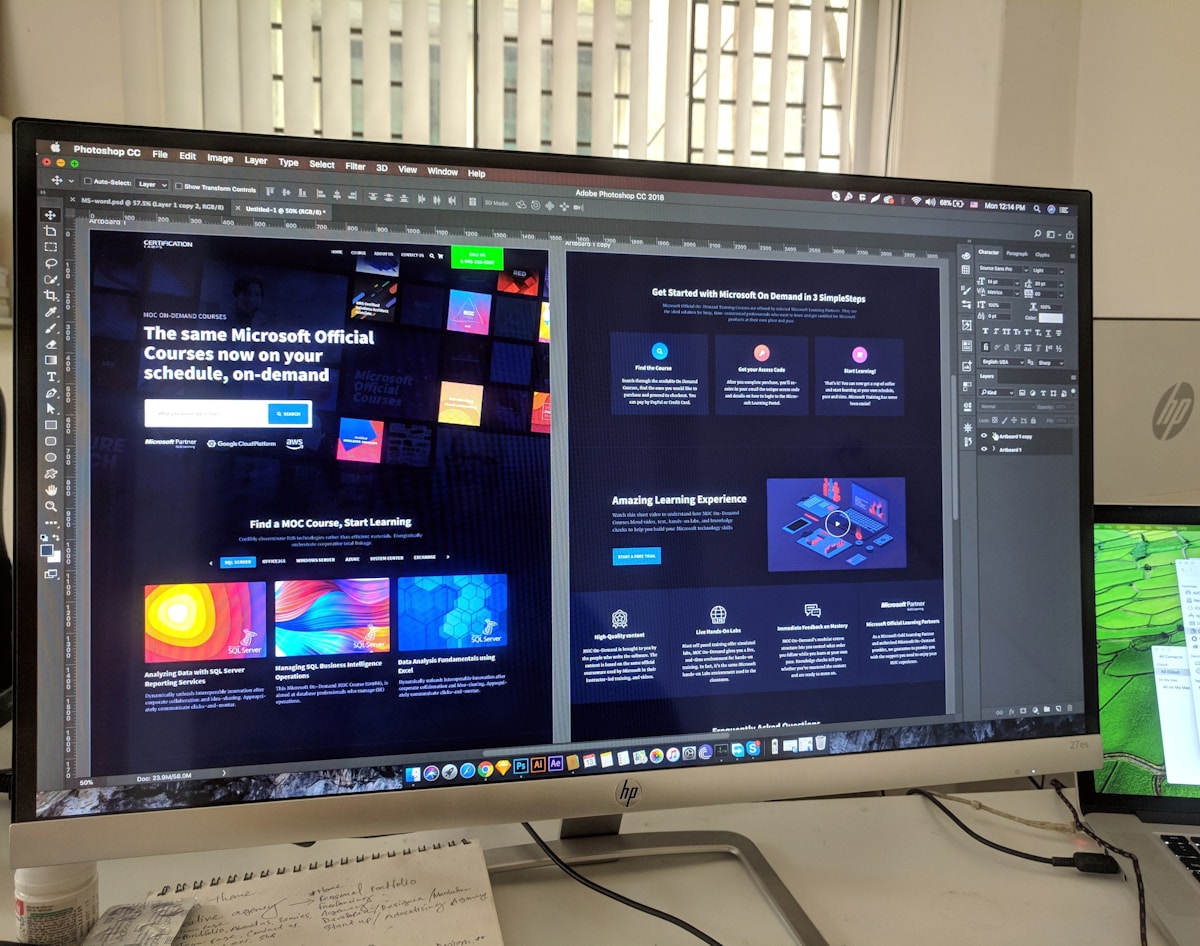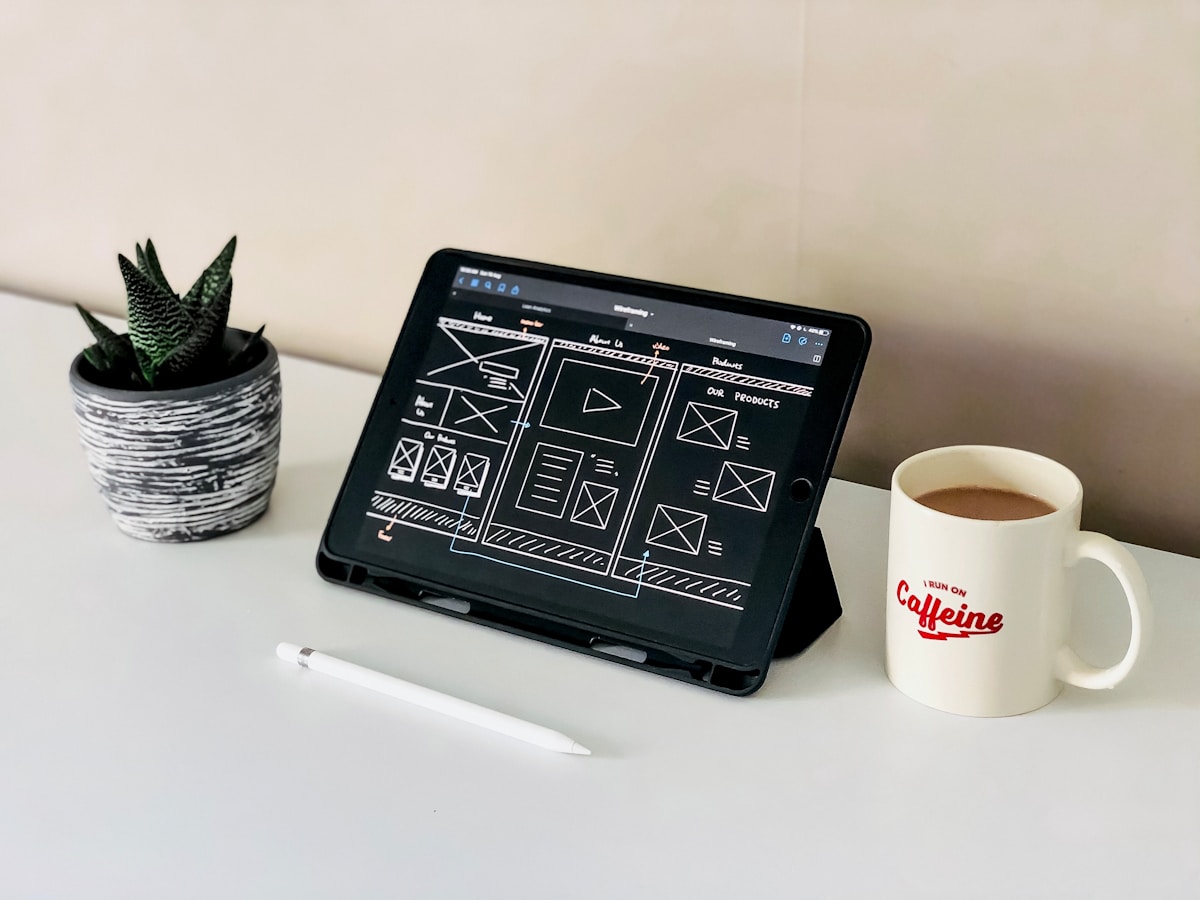Designing The Future: A Journey Into The World Of A Website Designer
Designing The Future: A Journey Into The World Of A Website Designer

In today's digital age, the importance of website design for the future cannot be overstated. As businesses and individuals increasingly rely on online platforms to connect with their target audience, the role of a website designer has become crucial. A designer creates visually appealing, user-friendly websites communicating a brand's message. To succeed in this field, professionals must possess key skills and qualities that set them apart.
The Importance Of Website Design For The Future
Website design is vital in shaping how users perceive a brand or organization. A well-designed website captures attention and enhances user experience, increasing engagement and conversions. As more businesses recognize the significance of establishing an online presence, the demand for skilled website designers grows. With technology constantly evolving, designers must stay updated with emerging trends and adapt their designs accordingly.
Understanding The Role Of A Website Designer
A website designer is responsible for creating aesthetically pleasing layouts that are both visually appealing and functional. They work closely with clients to understand their requirements and translate them into engaging, user-friendly designs. Website designers must also understand branding principles to ensure consistency across various platforms. Additionally, they must possess strong problem-solving skills to address technical issues during the design process.
Key Skills And Qualities Of A Successful Website Designer
There are several key skills and qualities that one must possess to excel as a professional website designer:
- Creativity. Website designers must think outside the box and develop innovative solutions that captivate users.
- Technical proficiency. Proficiency in HTML, CSS, JavaScript, and other coding languages is essential for implementing designs effectively.
- Attention to detail. Every element on a website should be carefully crafted to create a seamless user experience.
- Communication skills. Website designers must effectively communicate with clients and understand their vision to deliver successful designs.
- Time management. Meeting deadlines and managing multiple projects simultaneously is crucial in this fast-paced industry.
Honing these skills and qualities can help aspiring website designers position themselves as professionals who can create visually stunning and functional websites that leave a lasting impression on users.
The Journey Of Becoming A Website Designer

How To Become A Website Designer?
Becoming a website designer is an exciting and rewarding career choice for those passionate about creativity and technology. Exploring the various paths available in this field is important to embark on this journey. Some individuals may pursue formal education in web design, while others may opt for self-study and online courses.
One path to becoming a website designer is obtaining a degree in web design or a related field, such as graphic design or computer science. Formal education provides a solid foundation in design principles, coding languages, and user experience (UX) design. It also offers opportunities for hands-on projects and collaboration with peers.
One of the most efficient tips to become a website designer is self-study and online courses. Many aspiring designers learn web design through online tutorials, video courses, and interactive platforms. The flexible approach allows individuals to learn independently and gain practical HTML, CSS, JavaScript, and responsive design skills.
Essential Education And Training For Aspiring Designers
Regardless of the path chosen, there are essential education and training requirements for aspiring website designers. These include:
- Proficiency in HTML/CSS. HTML (Hypertext Markup Language) and CSS (Cascading Style Sheets) are the building blocks of web design. Understanding these coding languages is crucial for creating visually appealing websites.
- Knowledge of Design Principles. A good website designer should have an eye for aesthetics and an understanding of design principles such as color theory, typography, layout composition, and visual hierarchy.
- UX Design Skills. User experience (UX) design focuses on creating websites that are easy to navigate, intuitive to use, and provide a positive user experience. Aspiring designers should familiarize themselves with UX principles such as usability testing, wireframing, prototyping, and user research.
- Familiarity with Design Software. Proficiency in design software such as Adobe Photoshop, Illustrator, or Sketch is essential for creating and manipulating visual elements in web design.
Gaining Practical Experience Through Internships And Freelance Work
To further enhance their skills and gain practical experience, aspiring website designers can consider internships and freelance work opportunities. These experiences provide valuable hands-on experience, exposure to real-world projects, and the chance to collaborate with professionals in the industry.
Internships allow individuals to work under the guidance of experienced designers within a professional setting. It provides an opportunity to apply theoretical knowledge practically while learning from seasoned professionals.
Freelancing offers the flexibility of working on various projects for different clients. It allows aspiring designers to build portfolios, gain exposure to different industries, and develop client communication skills. Freelance platforms such as Upwork or Fiverr provide a platform for connecting with potential clients and showcasing one's skills.
Gaining practical experience through internships and freelance work helps aspiring website designers refine their skills and demonstrates their ability to work independently and meet client expectations.
Mastering The Art Of Web Design

Principles Of Effective Website Design
It is crucial to understand and apply the principles of effective website design to become a professional website designer. These principles guide the creation of visually appealing and functional websites that engage users and deliver a seamless experience.
One important principle is simplicity. A clutter-free design with clear navigation enhances the user experience and makes it easier for visitors to find what they want. Another principle is consistency, which uses consistent fonts, colors, and layouts throughout the website to create a cohesive look.
Additionally, incorporating whitespace or negative space is essential in providing visual breathing room and highlighting important elements on the page. It helps to make sure visitors have enough information at a time.
User Experience (UX) Design And Its Impact
User Experience (UX) design is critical in website design as it creates meaningful and enjoyable interactions between users and websites. UX designers aim to understand user behavior, needs, and preferences to optimize their experience on a website.
Conducting user research can help UX designers gain insights into how users navigate websites, what features they find useful or frustrating, and how to improve overall usability. The information guides the design process by ensuring that websites are intuitive, easy to navigate, and provide relevant content.
Incorporating Visual Elements And Branding Into Designs
Visual elements are an integral part of web design as they help convey messages effectively while enhancing the overall aesthetic appeal of a website. As a website designer, it is essential to strategically incorporate visual elements such as images, videos, icons, and infographics throughout the site.
Furthermore, branding plays a crucial role in web design by establishing a consistent online identity for businesses or individuals. Website designers create cohesive experiences that align with their client's brand image by incorporating brand colors, logos, fonts, and other visual elements into designs.
Website Design Tools And Technologies

Website design tools and technologies play a crucial role in the success of a website designer. These tools enable designers to create visually appealing and functional websites that meet the needs of their clients. The following section will explore some essential website design software, the benefits of leveraging content management systems (CMS), and the importance of responsive design for optimal user experience.
Introduction To Website Design Software
Website design software is an essential tool for every professional website designer. It provides a platform for creating, editing and managing web pages without writing complex code from scratch. Some popular website design software includes:
- Adobe Dreamweaver. A powerful software that allows designers to create websites using visual design tools and code editing capabilities.
- Sketch. Designers widely use the software for creating user interfaces (UI) and interactive prototypes.
- WordPress. While primarily known as a CMS, WordPress offers a user-friendly interface for designing websites using pre-built themes or custom templates.
Website design software significantly speeds up the development process and allows designers to focus on creativity rather than technicalities.
Leveraging Content Management Systems (CMS)
Content management systems (CMS) simplify the process of managing website content, making it easier for website designers to create, update, and organize web pages without extensive coding knowledge. Some popular CMS options include:
- WordPress. As mentioned earlier, WordPress is a website design software and a widely used CMS with an extensive library of themes and plugins.
- Joomla. Joomla is another popular CMS that offers flexibility in terms of customization options and scalability for larger websites.
- Drupal. Known for its robustness and security features, Drupal is often chosen by organizations with complex web development needs.
Website designers can streamline workflow, collaborate with clients more effectively, and update content as needed by leveraging CMS platforms.
Responsive Design For Optimal User Experience
In today's mobile-centric world, responsive design has become crucial to website development. Responsive design ensures that websites adapt seamlessly to different screen sizes and devices, providing an optimal user experience. Some key considerations for implementing responsive design include:
- Fluid layouts. Designers must create flexible layouts that adjust to various screen sizes, ensuring content is displayed correctly across devices.
- Media queries. Using media queries in CSS, designers can apply different styles and layouts based on the device's screen resolution.
- Mobile-first approach. Designing with a mobile-first mindset ensures that the website is optimized for smaller screens and progressively enhanced for larger devices.
Implementing responsive design improves user experience and positively impacts search engine rankings, as search engines prioritize mobile-friendly websites.
Creating Engaging And Functional Websites

Planning And Structuring Website Content
When it comes to creating engaging and functional websites, planning and structuring website content is crucial. As a website designer, it is important to understand the goals and objectives of the website, as well as the target audience. It will help in determining the appropriate content strategy.
To effectively plan and structure website content, consider the following website designer tips:
- Conduct thorough research. Understand the industry or niche that the website belongs to. It will help determine what content will resonate with the target audience.
- Define clear goals. Define what the website aims to achieve. Is it to inform, sell products/services, or generate leads? Having clear goals will guide your content creation process.
- Create a logical hierarchy. Hierarchically organize your content to ensure easy navigation for users. Use headings, subheadings, and bullet points to break down information into digestible chunks.
- Use compelling visuals. Incorporate relevant images, videos, infographics, or illustrations to enhance your content's visual appeal and engage users.
- Write concise and compelling copy. Craft persuasive copy that effectively communicates key messages while keeping it concise and easy to read.
Remember that effective planning and structuring of website content can greatly impact user engagement and the overall success of a website design project.
Optimizing Websites For Search Engines
Optimizing websites for search engines is essential for increasing visibility and driving organic traffic. A professional website designer must understand search engine optimization (SEO) techniques.
Consider these tips when optimizing websites for search engines:
- Keyword research. Identify relevant keywords commonly used by your target audience. Incorporate these keywords throughout your website content, including titles, headings, and meta tags.
- On-page optimization. Use relevant keywords in your website's meta titles, descriptions, and URLs. Use header tags to organize your information and make it simpler for search engines to read (H1, H2).
- Mobile optimization. With the increasing use of mobile devices, ensuring that your website is responsive and mobile-friendly is important. It improves user experience and helps with search engine rankings.
- Page speed optimization. Optimize your website's loading speed by compressing images, minifying CSS and JavaScript files, and leveraging browser caching. A fast-loading website enhances user experience and improves search engine rankings.
- Quality backlinks. Build high-quality backlinks from reputable websites to improve your website's authority in the eyes of search engines. It can be achieved through guest blogging, social media promotion, or engaging with industry influencers.
Remember that optimizing websites for search engines requires ongoing effort and staying up-to-date with the latest SEO trends and algorithms.
Integrating E-commerce Functionality And Security Measures
As an aspiring professional website designer, understanding how to integrate e-commerce functionality and implement security measures is essential for creating functional websites prioritizing user trust and safety.
Consider the following website designer tips when integrating e-commerce functionality:
- Choose a secure payment gateway. Select a reliable payment gateway that offers secure transactions for customers. Popular options include PayPal, Stripe, or Square.
- Implement SSL certificate. Install an SSL certificate on the website to encrypt sensitive customer data during online transactions. It helps protect against potential cyber threats.
- User-friendly shopping cart. Design an intuitive shopping cart system that allows users to easily add products, view their selections, and seamlessly proceed through checkout.
- Product categorization. Organize products into categories or collections to make it easier for users to find what they want. Implement filters and search functionality to enhance the user experience.
- Trust badges and customer reviews. Display trust badges, such as security seals or SSL certificates, to instill customer confidence. Additionally, encourage customers to leave reviews and testimonials to build trust and credibility.
You can create a seamless online shopping experience for users while protecting their information by integrating e-commerce functionality and implementing security measures.
Collaborating With Clients And Building A Portfolio

As a professional website designer, effective client communication and understanding of requirements are crucial skills. Listening to clients' needs and goals can help ensure the final design aligns with their vision. Regularly engaging in open and transparent communication helps to establish trust and maintain a positive working relationship.
Showcasing your work through an online portfolio is essential for enticing potential clients and demonstrating your expertise as a website designer. A well-curated portfolio should include a variety of projects that highlight your range of skills and creativity. Use high-quality visuals, detailed descriptions, and client testimonials to showcase the success of your designs.
Building a professional network is another important aspect of a successful website designer. Networking allows you to connect with other professionals in the industry, collaborate on projects, and gain valuable insights. Attend industry events, join online communities or forums, and actively engage with others on social media platforms to expand your network.
Marketing yourself as a website designer is key to attracting clients and standing out in the competitive market. Create a professional website or blog where you may display your knowledge through enlightening articles or case studies to build a strong personal brand. Use social media to share your work, interact with potential customers, and position yourself as an industry leader.
Can Strikingly Act As Your Website Designer?
Certainly, Strikingly can serve as your website designer. Here's how:
- Templates- Strikingly offers a wide range of professionally designed website templates. You can choose a template that aligns with your style and business needs.

Image taken from Strikingly
- Customization- You can customize the selected template to match your brand's colors, fonts, and imagery. It allows you to create a unique and personalized website.

Image taken from Strikingly
- Drag-and-Drop Editor- Strikingly's intuitive drag-and-drop editor makes adding and arranging elements on your website, such as text, images, videos, and forms, easy.

Image taken from Strikingly
- Mobile Optimization- Strikingly ensures your website looks great on mobile devices by automatically optimizing the layout for smaller screens.

Image taken from Strikingly
- E-commerce Integration- If you're selling products or services online, Strikingly offers e-commerce features to set up an online store, manage products, and process payments.

Image taken from Strikingly
- SEO Tools- Strikingly provides built-in SEO tools to help improve your website's visibility on search engines. You can optimize meta tags, titles, and descriptions.

Image taken from Strikingly
- Blog Functionality- You can easily add a blog section to your website, allowing you to publish content and engage with your audience regularly.

Image taken from Strikingly
- Contact Forms- Strikingly allows you to create contact forms that visitors can use to contact you. You can collect inquiries and customer information.

Image taken from Strikingly
- Analytics- Gain insights into your website's performance with Strikingly's analytics tools. Monitor visitor statistics, traffic sources, and user behavior.

Image taken from Strikingly
- Domain Integration- You can connect your custom domain to your Strikingly website, giving it a professional and branded web address.

Image taken from Strikingly
- Support and Resources- Strikingly offers customer support and resources like tutorials and documentation to help you navigate and make the most of their platform.

Image taken from Strikingly
- Social Media Integration- Easily integrate your social media profiles and feeds into your website to boost your online presence.

Image taken from Strikingly
- Third-Party Integrations- Strikingly supports various third-party integrations, allowing you to connect your website with tools like email marketing platforms and analytics services.

Image taken from Strikingly
Using Strikingly's user-friendly platform and these features can effectively design and launch your website without extensive coding or design skills.
Conclusion
In an ever-evolving digital landscape, website design remains paramount. Websites serve as vital hubs for organizations and individuals, enabling them to connect with their audience, showcase offerings, and stay relevant in a tech-driven world.
To thrive in this dynamic field, designers must continually adapt to emerging technologies like AI, VR, and interactive interfaces. Staying ahead of the curve is key to delivering cutting-edge solutions to clients.
Enter Strikingly, the website builder that empowers designers. With its intuitive interface and customizable templates, Strikingly unleashes your creativity without coding headaches. It offers responsive design, SEO tools, e-commerce capabilities, and secure hosting, making it your go-to platform.
Ready to level up your web design game? Explore Strikingly today and craft visually stunning, functional websites that set you apart in the competitive design world.
